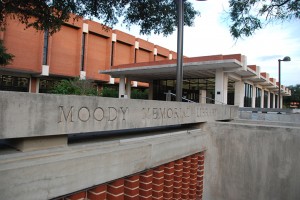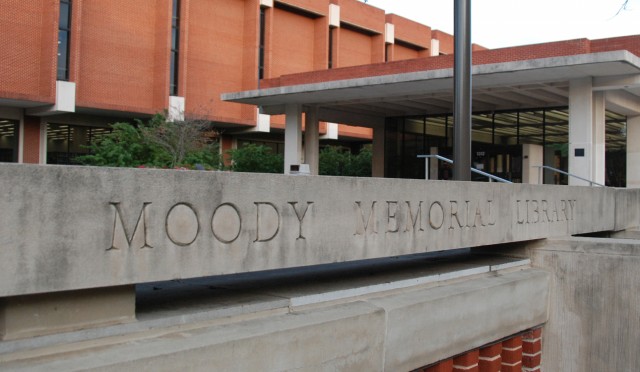
and Kara Blomquist
Reporters
A group of five students kick around a volleyball, playing soccer, around 10:30 p.m. on a Wednesday. They share stories of their day amid laughter. It’s not intramural practice. It’s the second floor corridor between Moody Memorial Library and Jessie H. Jones Library.
Over the years, the central libraries have changed the function of some of their spaces, but no gym has been added. These libraries include Moody, built in 1968, and Jones, built in 1992. In fact, no square footage has been added to the central libraries since their construction.
Some say that limited space is an issue in the central libraries.
On-site resources and a growing student population both vie for space in the libraries. This leaves some students feeling crowded and wishing for more space, several students said. Library officials said they are working to meet students’ needs within the space they have.
The square footage of the central libraries hasn’t increased. “We haven’t expanded beyond the footprint,” said Pattie Orr, vice president for Information Technology and dean of University Libraries.
The central libraries haven’t expanded, but the student population has. Baylor reached a record enrollment of 15,364 students in the fall of 2012.
These students have the same central library space as students in 1992, when the enrollment was 12,185.
“Could we use more space?” Orr said. “I guess we always can.”
A feasibility study conducted in 2003 produced a vision of a six-floor Moody, said Jeff Steely, associate dean and director of University Libraries.
“When Moody was built, there was the intention that it could expand upwards,” Steely said.
The addition of two floors would have required heavier structural engineering, increasing the cost of construction, he said.
One of the additional floors was proposed as a dining facility, he said.
The university initially approved a modified plan based on the study.
Steely said he was unable to release the exact cost of the proposed plan.
“It wasn’t really a public document,” he said. “It was for internal use.”
The cost of the proposed plan was an upper eight-figure amount, Steely said.
“Of course it’s going to be a very obsolete number, partly because it’s a decade old,” he said. “I really have no idea how useful that number is.”
No aspect of the plan was implemented because there was not enough money available for the project.
Steely said the changing cost of construction and steel would affect the cost of the plan now.
This plan wouldn’t be implemented today, he said. Some of the university needs in 2003 have since been met by other campus changes, such as a number of food options that have been added to campus.
“Right now, we’re focusing on how to use the space that we do have most effectively,” Steely said.
The central libraries have undergone some internal changes to make the space more functional, Orr said.
“When I came in 2007, we were bursting at the seams after hours,” she said.
From 2008-2010, the garden level of Moody became more student-friendly, Steely said.
Before the renovation, book stacks filled the Moody Garden Study Commons leaving study space dispersed around the walls. All of the books except for the children’s collection were integrated into other floors. This created more space for students. Other changes include putting electrical outlets in the study carrels, adding an entrance to Moody from the garden on the lower level and opening a Starbucks.
“As you renovate, it makes the space more functional,” Orr said.
Donor money funded all of these updates.
“Our regular budget would never have allowed for those kind of things,” Orr said. The budget last year for all university libraries was $16.5 million, according to the Baylor University Libraries’ website.
Houston senior Chris Egbunike said he thinks the addition of the Starbucks changed the study environment of the foyer.
“Before it used to be a good place for group study,” he said. “Now people just come up here to grab coffee. It might as well just be another Club Moody.”
Egbunike said sometimes he has trouble simply finding a place to sit.
“Everyone is trying to scramble for a seat,” he said.
Some students said they think Moody and Jones can’t accommodate all of the students.
“It’s always getting really cramped and loud,” said Belton freshman Amanda Sarinana.
In 2003, students reported feeling crowded in the central libraries, according to a survey sent to students, faculty and staff. Students preferred the study carrels in Jones because the carrels in Moody were too small, as reported by the Lariat.
Steely said he recognizes that students would benefit from more quiet space in the libraries.
“I know there’s still a need,” he said. “We’re always looking for new ways and open to suggestions.”
In addition to study areas, book stacks also take up space in the central libraries.
Some students said they hardly ever come to the library for the book stacks.
The same night that college kids were playing soccer upstairs, students lined the walls of the first floor of Moody. One student looked through the book stacks there.
Austin junior Kyle Hopkinson said he has checked out four books in his Baylor career, one of which was for recreational reading
Several said they have yet to check out a physical book
Plano sophomore Holland Thompson said she uses the library’s online resources instead of checking out bound books.
Mission Viejo, Calif., Jordan Bode, student worker for the central libraries, said on average, five to six people check out books every hour.
Between 2002-2012, the amount of materials circulated has decreased by 25,974 items. In 2012, 272,468 materials were circulated. These numbers include all university libraries.
Steely said this trend is not unique to Baylor.
“I know that general trends across academic libraries is that there’s been some decline,” he said.
The central libraries don’t track the number of students that check out books, Steely said. The libraries follow the number of materials circulated.
Steely said Baylor needs a large collection of physical books on-site.
He said the interlibrary loan system is one reason Baylor needs a big collection of resources.
Baylor loans and receives materials from institutions both in the United States and abroad through its interlibrary loan system.
“If we don’t have a book, we reach out to other schools,” said Jimmie Sauer, who works in Exit Services at Moody.
While materials can be accessed from other libraries within the system, Baylor must maintain its large collection on-site in order to play fair, Steely said.
He said he has seen some schools cut back their book buying.
“They become a drain on the whole system,” Steely said. “They become a net borrower.”
Baylor is a net lender. Last year, Baylor loaned about 30,000 more items than it received.
Baylor’s large collection takes up space, most of which is housed on-site.
The off-site materials are housed at the O’Grady storage facility, located on LaSalle.
“When I first came, there was a discussion about additional storage so we could make more study space,” Orr said.
No additional storage space was created because most of the libraries’ growth is in electronic resources.
Students share the library with the majority of Baylor’s book collection. These conditions leave some students wishing for more space.
“With a campus our size, we need another library,” Wylie junior Megan Judd said.
Steely said he is looking for ways to improve the libraries.
“We are listening to input students give,” he said.
All students can give suggestions by filling out a comment form on the library website at https://www.baylor.edu/lib click ‘about us’ then click ‘contact us.’


